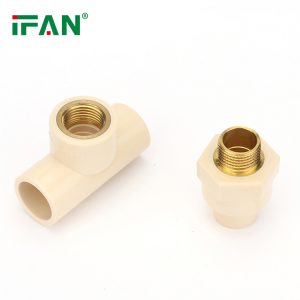Description
IFAN factory 30+ years manufacture experience support color /size customization support free sample.Welcome to consult for catalog and free samples.This is our Facebook Website:www.facebook.com,Click to watch IFAN’s product video.Compared with Tomex products, our IFAN products from quality to price are your best choice, welcome to buy!
Introduction
CPVC (Chlorinated Polyvinyl Chloride) fittings have become integral components in modern building design due to their durability, chemical resistance, and ease of installation. Integrating CPVC fittings into building systems requires careful planning and consideration of various factors to ensure efficiency, reliability, and compliance with safety standards. This article explores the key aspects of CPVC fitting system integration in building design, highlighting its applications, benefits, installation considerations, and future trends.
Applications of CPVC Fittings
CPVC fittings find extensive applications across residential, commercial, and industrial sectors within building infrastructure. In residential settings, CPVC fittings are commonly used for potable water distribution due to their resistance to scaling and corrosion, ensuring long-term water quality and system integrity. In commercial buildings such as offices and hotels, CPVC fittings support HVAC (Heating, Ventilation, and Air Conditioning) systems by efficiently conveying hot and cold water, maintaining optimal indoor climate control. Industrial facilities utilize CPVC fittings for handling corrosive fluids, where their chemical resistance properties mitigate the risk of leaks or contamination. The versatility of CPVC fittings extends to fire sprinkler systems, where their inherent fire resistance and ease of installation provide critical safety measures. Thus, CPVC fittings play a pivotal role in enhancing the functionality and reliability of diverse building applications.

Benefits of CPVC Fittings
The adoption of CPVC fittings offers several advantages over traditional materials like metal or PVC. Firstly, CPVC fittings are lightweight yet robust, simplifying handling and installation processes while reducing labor costs. Their smooth interior surface minimizes frictional losses within piping systems, optimizing fluid flow efficiency and reducing energy consumption associated with water distribution and HVAC operations. CPVC’s superior corrosion resistance ensures longevity, minimizing maintenance requirements and lifecycle costs compared to metal fittings prone to rust or corrosion. Additionally, CPVC fittings are environmentally friendly, as they are recyclable and contribute to sustainable building practices by conserving water and energy resources. These benefits collectively underscore CPVC fittings as a preferred choice for modern building design, balancing performance, durability, and environmental stewardship.
Considerations for Installation
Successful integration of CPVC fittings into building design necessitates adherence to established installation practices and regulatory standards. Prior to installation, careful assessment of system requirements and specifications is crucial to determine appropriate CPVC pipe sizes, fittings, and jointing methods. Proper alignment and support of CPVC pipes and fittings prevent stress-induced failures and ensure structural integrity under varying operational conditions. Installation techniques such as solvent cement bonding or mechanical joints should comply with manufacturer guidelines and local building codes to guarantee leak-free connections and system performance. Periodic inspections and pressure testing verify installation integrity and identify potential issues before commissioning, safeguarding against operational disruptions and costly repairs. By prioritizing meticulous planning and skilled craftsmanship, architects, engineers, and contractors can optimize CPVC fitting installations to deliver reliable, efficient building systems tailored to specific project requirements.

Future Trends and Innovations
Looking ahead, ongoing advancements in CPVC fitting technology promise enhanced performance and versatility in building design applications. Innovations in material formulations aim to further enhance CPVC’s resistance to extreme temperatures and aggressive chemicals, expanding its utility in specialized environments such as healthcare facilities and industrial plants. Integration of smart technologies and IoT (Internet of Things) capabilities within CPVC fittings enables real-time monitoring of system parameters, facilitating proactive maintenance and energy management strategies. Collaborative research initiatives and industry partnerships continue to drive innovation, promoting sustainable practices and regulatory compliance in building construction and infrastructure development. As building design trends increasingly prioritize energy efficiency, environmental sustainability, and occupant comfort, CPVC fittings are poised to play an indispensable role in shaping the future of resilient, high-performance building systems.
Conclusion
In conclusion, CPVC fitting system integration in building design represents a cornerstone of modern infrastructure solutions, offering durability, efficiency, and compliance with stringent safety and environmental standards. From residential plumbing to industrial applications, CPVC fittings embody a versatile, cost-effective solution that enhances system performance while minimizing lifecycle costs. As technological advancements and regulatory requirements evolve, the versatility and adaptability of CPVC fittings ensure their continued relevance and adoption across diverse building projects worldwide. By embracing CPVC fittings in building design, stakeholders can achieve sustainable, resilient infrastructure that meets the demands of today’s dynamic construction landscape.
This comprehensive overview underscores the pivotal role of CPVC fittings in driving innovation and efficiency across building design disciplines, reinforcing their status as a preferred choice for future-ready infrastructure solutions.
Related products
-
CPVC ASTM2846
PVC fittings: The versatile choice for DIY projects
-
CPVC ASTM2846
Why is CPVC not used anymore?












